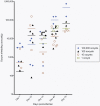Cryptosporidium parvum infection in SCID mice infected with only one oocyst: qPCR assessment of parasite replication in tissues and development of digestive cancer
- PMID: 23272093
- PMCID: PMC3521773
- DOI: 10.1371/journal.pone.0051232
Cryptosporidium parvum infection in SCID mice infected with only one oocyst: qPCR assessment of parasite replication in tissues and development of digestive cancer
Abstract
Dexamethasone (Dex) treated Severe Combined Immunodeficiency (SCID) mice were previously described as developing digestive adenocarcinoma after massive infection with Cryptosporidium parvum as soon as 45 days post-infection (P.I.). We aimed to determine the minimum number of oocysts capable of inducing infection and thereby gastrointestinal tumors in this model. Mice were challenged with calibrated oocyst suspensions containing intended doses of: 1, 10, 100 or 10(5) oocysts of C. parvum Iowa strain. All administered doses were infective for animals but increasing the oocyst challenge lead to an increase in mice infectivity (P = 0.01). Oocyst shedding was detected at 7 days P.I. after inoculation with more than 10 oocysts, and after 15 days in mice challenged with one oocyst. In groups challenged with lower inocula, parasite growth phase was significantly higher (P = 0.005) compared to mice inoculated with higher doses. After 45 days P.I. all groups of mice had a mean of oocyst shedding superior to 10,000 oocyst/g of feces. The most impressive observation of this study was the demonstration that C. parvum-induced digestive adenocarcinoma could be caused by infection with low doses of Cryptosporidium, even with only one oocyst: in mice inoculated with low doses, neoplastic lesions were detected as early as 45 days P.I. both in the stomach and ileo-caecal region, and these lesions could evolve in an invasive adenocarcinoma. These findings show a great amplification effect of parasites in mouse tissues after challenge with low doses as confirmed by quantitative PCR. The ability of C. parvum to infect mice with one oocyst and to develop digestive adenocarcinoma suggests that other mammalian species including humans could be also susceptible to this process, especially when they are severely immunocompromised.
Conflict of interest statement
Figures


References
-
- Chen Z, Mi R, Yu H, Shi Y, Huang Y, et al. (2011) Prevalence of Cryptosporidium spp. in pigs in Shanghai, China. Vet Parasitol 181: 113–119. - PubMed
-
- Ramirez NE, Ward LA, Sreevatsan S (2004) A review of the biology and epidemiology of cryptosporidiosis in humans and animals. Microbes Infect 6: 773–785. - PubMed
-
- Yang R, Fenwick S, Potter A, Ng J, Ryan U (2011) Identification of novel Cryptosporidium genotypes in kangaroos from Western Australia. Vet Parasitol 179: 22–27. - PubMed
-
- Chappell CL, Okhuysen PC, Langer-Curry R, Widmer G, Akiyoshi DE, et al. (2006) Cryptosporidium hominis: experimental challenge of healthy adults. Am J Trop Med Hyg 75: 851–857. - PubMed
-
- Chappell CL, Okhuysen PC, Sterling CR, DuPont HL (1996) Cryptosporidium parvum: intensity of infection and oocyst excretion patterns in healthy volunteers. J Infect Dis 173: 232–236. - PubMed

